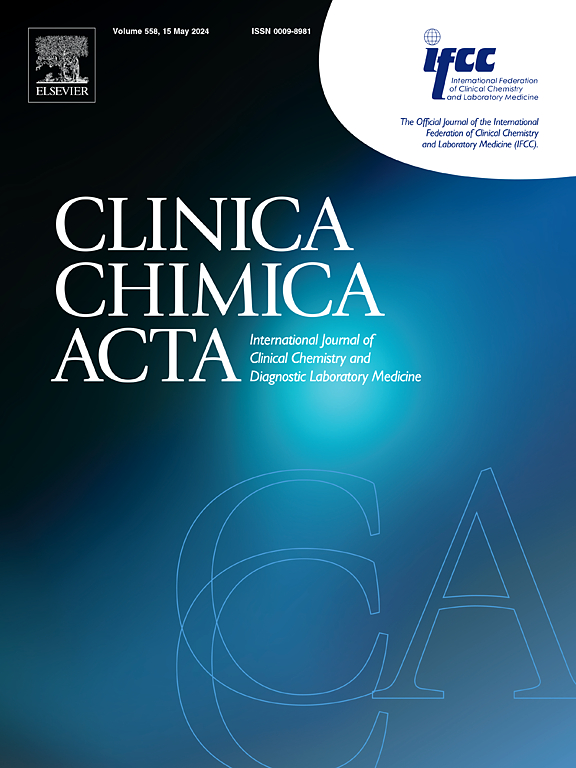Early diagnosis of the Need for surgical drainage in chronic pancreatitis patients based on serum metabolomics
IF 3.2
3区 医学
Q2 MEDICAL LABORATORY TECHNOLOGY
引用次数: 0
Abstract
Purpose
Chronic pancreatitis (CP) is a chronic inflammatory disease caused by multiple factors. Numerous studies have found that implementing surgical drainage in the early stages of CP can help alleviate pain and improve prognosis in patients. However, there is currently no consensus on clinical indications for surgical drainage in the early stages of CP, making it difficult to determine whether surgical drainage is necessary. This study aims to use metabolomics methods to identify potential biomarkers that can differentiate whether CP patients require surgical drainage.
Methods
This study included two cohorts. The training cohort consisted of 32 serum samples from CP patients and 31 serum samples from healthy controls. The validation cohort comprised 73 serum samples from CP patients and 27 serum samples from healthy controls. All serum samples from CP patients were collected within 24 h of hospital admission. Liquid chromatography-tandem mass spectrometry (LC-MS) was used to perform metabolomic analysis on all collected serum samples.
Results
Based on the validation cohort, 24 differential metabolites, including 1-(6-[3]-ladderane-hexanyl)-2-(8-[3]-ladderane-octanyl)-sn-glycerophosphocholine, PE(18:1(9Z)/20:4(5Z,8Z,11Z,14Z)), and PGP(16:0/20:4(5Z,8Z,11Z,14Z)), were identified as potential biomarkers for distinguishing whether CP patients require surgical drainage. Among these, the combination of 1-(6-[3]-ladderane-hexanyl)-2-(8-[3]-ladderane-octanyl)-sn-glycerophosphocholine and PE(18:1(9Z)/20:4(5Z,8Z,11Z,14Z)) demonstrated improved diagnostic value in joint ROC analysis, with an AUC value of 0.819 (95% CI: 0.691–0.924).
Conclusion
This study represents the first prospective cohort research to identify 24 differential metabolites in serum through metabolomic profiling, which can be used for the early diagnosis of whether CP patients require surgical drainage.
基于血清代谢组学的慢性胰腺炎患者手术引流需求早期诊断。
目的:慢性胰腺炎(CP)是一种由多种因素引起的慢性炎症性疾病。大量研究发现,在CP早期实施手术引流可以帮助患者减轻疼痛,改善预后。然而,目前对于CP早期手术引流的临床指征尚未达成共识,因此难以确定是否需要手术引流。本研究旨在利用代谢组学方法鉴定可能区分CP患者是否需要手术引流的生物标志物。方法:本研究包括两个队列。训练队列包括来自CP患者的32份血清样本和来自健康对照的31份血清样本。验证队列包括来自CP患者的73份血清样本和来自健康对照的27份血清样本。所有CP患者的血清样本均在入院后24 h内采集。采用液相色谱-串联质谱(LC-MS)对采集的血清样本进行代谢组学分析。结果:基于验证队列,确定了24种差异代谢物,包括1-(6-[3]- ladder烷-己基)-2-(8-[3]- ladder烷-辛烷)- cn -甘油胆碱,PE(18:1(9Z)/20:4(5Z,8Z,11Z,14Z))和PGP(16:0/20:4(5Z,8Z,11Z,14Z)),作为区分CP患者是否需要手术引流的潜在生物标志物。其中,1 -(6-[3]- ladderne -hexanyl)-2-(8-[3]- ladder烷-辛烷)- cn - glycerophocholine and PE(18:1(9Z)/20:4(5Z,8Z,11Z,14Z))联合应用在联合ROC分析中具有较好的诊断价值,AUC值为0.819 (95% CI: 0.691-0.924)。结论:本研究首次通过代谢组学分析鉴定血清中24种差异代谢物的前瞻性队列研究,可用于早期诊断CP患者是否需要手术引流。
本文章由计算机程序翻译,如有差异,请以英文原文为准。
求助全文
约1分钟内获得全文
求助全文
来源期刊

Clinica Chimica Acta
医学-医学实验技术
CiteScore
10.10
自引率
2.00%
发文量
1268
审稿时长
23 days
期刊介绍:
The Official Journal of the International Federation of Clinical Chemistry and Laboratory Medicine (IFCC)
Clinica Chimica Acta is a high-quality journal which publishes original Research Communications in the field of clinical chemistry and laboratory medicine, defined as the diagnostic application of chemistry, biochemistry, immunochemistry, biochemical aspects of hematology, toxicology, and molecular biology to the study of human disease in body fluids and cells.
The objective of the journal is to publish novel information leading to a better understanding of biological mechanisms of human diseases, their prevention, diagnosis, and patient management. Reports of an applied clinical character are also welcome. Papers concerned with normal metabolic processes or with constituents of normal cells or body fluids, such as reports of experimental or clinical studies in animals, are only considered when they are clearly and directly relevant to human disease. Evaluation of commercial products have a low priority for publication, unless they are novel or represent a technological breakthrough. Studies dealing with effects of drugs and natural products and studies dealing with the redox status in various diseases are not within the journal''s scope. Development and evaluation of novel analytical methodologies where applicable to diagnostic clinical chemistry and laboratory medicine, including point-of-care testing, and topics on laboratory management and informatics will also be considered. Studies focused on emerging diagnostic technologies and (big) data analysis procedures including digitalization, mobile Health, and artificial Intelligence applied to Laboratory Medicine are also of interest.
 求助内容:
求助内容: 应助结果提醒方式:
应助结果提醒方式:


